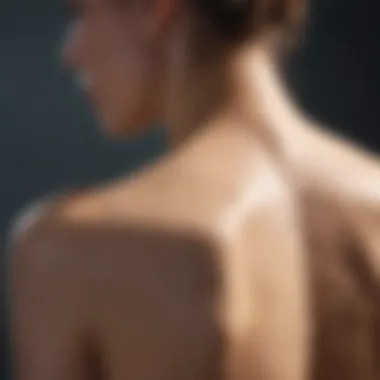Effective Solutions for Back Acne Wash


Intro
Back acne, medically known as bacne, is an issue that affects many people, particularly women aged 18 to 45. This skin condition can lead to discomfort and a lack of confidence. The area of the back does not always receive the same care as the face or other visible parts, making it vital to address. Knowledge about effective washing solutions and selection of proper products is essential in managing bacne.
The market offers various options for treating back acne, which can be overwhelming. This article breaks down the complexities and aims to provide clear guidance on managing this condition. By understanding the causes of bacne, choosing the right products, and practicing effective washing techniques, you can achieve healthier skin.
This guide will cover recent trends in bacne treatment, including innovative beauty products, and offer step-by-step guides on effective washing techniques and routines. Additionally, it will provide product reviews that delve into popular bacne treatments, allowing you to make informed choices.
As you embark on this journey to clearer skin, gaining insight from experts and understanding the latest options are crucial steps. This comprehensive approach will equip you with the tools necessary to tackle back acne effectively.
Preface to Back Acne
Back acne, often referred to as "bacne," is a skin condition that can negatively impact self-esteem and body image. Talking about this issue helps to normalize a common experience and offers practical solutions. Understanding back acne not only empowers individuals to take control of their skin health but also guides the selection of effective treatments.
What is Back Acne?
Back acne is similar to facial acne, characterized by the formation of pimples, cysts, and sometimes, scarring on the back. This condition results from a combination of excess oil production, clogged pores, and bacteria on the skin. Hormonal fluctuations, particularly during puberty or menstruation, can elevate oil production, contributing to its occurrence. Many people may dismiss back acne as a minor issue, yet it has significant implications for personal comfort and confidence.
Prevalence and Demographics
Back acne is not limited to teenagers; it affects a widespread demographic ranging from adolescents to adults. Studies suggest that both men and women can experience back acne, but there may be variations in severity based on gender and hormonal influences. For example, women commonly encounter this issue during hormonal changes associated with their menstrual cycle or pregnancy. Furthermore, lifestyle factors, such as temperature and humidity, can exacerbate the condition. Understanding the prevalence of back acne helps to highlight its commonality and encourages open discussion about treatment options.
Increasing awareness of back acne can help reduce stigma and promote discussions about effective treatment solutions for all skin types.
Causes of Back Acne
Understanding the causes of back acne is crucial in addressing and preventing this skin condition effectively. Back acne, like acne on other areas of the body, emerges from a complex interplay of factors that can vary widely among individuals. Recognizing these causes can not only guide the selection of appropriate products and treatments but also empower individuals to make informed lifestyle choices that may lead to improved skin health. In this section, we explore various determinants, categorizing them into hormonal factors, material causes, and lifestyle influences. Each category provides insights into how back acne occurs and how to manage it better.
Hormonal Factors
Hormonal fluctuations play a significant role in the development of back acne, particularly during puberty, menstruation, pregnancy, and periods of stress. Androgens, a type of hormone that increases during these times, lead to increased sebum production in the skin. This excess oil can clog pores, resulting in acne. Moreover, hormonal imbalances can trigger inflammation, worsening existing acne and making treatment challenging.
- Key points to consider:
- Pay attention to your menstrual cycle and stress levels.
- Consider tracking acne outbreaks in relation to hormonal changes.
- Consult with a healthcare provider for testing if hormonal issues are suspected.
Material Causes
Material causes refer to environmental and external factors that contribute to back acne. These include the fabrics of clothing and the materials used in personal care products. Tight or non-breathable fabrics can trap moisture and heat, creating an ideal environment for bacteria and acne development. Furthermore, certain products, such as body lotions or sunscreens that contain heavy oils or comedogenic ingredients, may also clog pores.
- Things to avoid:
- Synthetic fabrics that do not wick moisture away from the skin.
- Heavy, greasy topical products that can exacerbate acne.
Lifestyle Influences
Lifestyle decisions significantly impact skin health and may aggravate back acne. High-stress levels can lead to increased sebum production, while a poor diet, particularly one high in sugar and dairy, has been linked to acne. Additionally, neglecting personal hygiene or failing to shower after sweating can allow bacteria to thrive on the skin, potentially leading to breakouts.


- Considerations include:
- Maintaining a balanced diet rich in whole foods and low in sugar.
- Managing stress through mindfulness or physical activities.
- Practicing good hygiene by showering regularly and using non-comedogenic products.
"Preventing back acne is not just about using the right products, but also about fostering a lifestyle that promotes skin clarity and health."
By understanding these interconnected causes, individuals can take proactive steps towards managing and preventing back acne effectively.
Choosing the Right Back Acne Wash
Selecting the right back acne wash is essential for managing this condition effectively. A suitable wash can help keep existing acne under control and prevent new breakouts. This decision is influenced by ingredients and formulation types, which cater to different skin types and acne severity. Users need to be aware of how product choices can impact skin health and overall experience with acne management.
Key Ingredients to Look For
Salicylic Acid
Salicylic acid is a beta hydroxy acid (BHA) known for its effectiveness in treating acne. It penetrates the pores and exfoliates the skin, helping to clear out excess oil and dead skin cells. This action reduces the chances of clogged pores and helps to manage inflammation. Salicylic acid is a popular choice due to its deep-cleansing abilities and has a reputation for being gentle on the skin, minimizing irritation for most users. However, it can be drying in some cases, so moderation in its use is advisable to avoid excessive dryness.
Benzoyl Peroxide
Benzoyl peroxide is another well-known ingredient in acne treatment. It kills bacteria that contribute to acne, making it a strong choice for active breakouts. It also helps to prevent new lesions from forming. The unique feature of benzoyl peroxide is its dual-action—acting as both an exfoliant and an antibacterial agent. While effective, it can cause irritation, and users with sensitive skin should introduce it gradually to avoid side effects like redness or peeling.
Tea Tree Oil
Tea tree oil is a natural alternative often used in back acne washes. It has antimicrobial properties that help combat acne-causing bacteria, making it effective in reducing blemishes. Its key characteristic is that it is less harsh than some synthetic treatments, appealing to those with sensitive skin concerns. While many find tea tree oil beneficial, others may experience allergic reactions, so patch testing is recommended before full application.
Formulations and Types
Gels
Gels are popular for back acne washes due to their lightweight nature. They typically offer a cooling sensation upon application and can penetrate the skin effectively. Their consistency allows for the incorporation of active ingredients that target acne. Gels often rinse off easily, leaving no residue, which makes them a preferred choice for many users. However, they may not provide as much moisture, which could be a drawback for individuals with dry skin.
Scrubs
Scrubs can provide a physical exfoliation that helps remove dead skin cells, potentially reducing acne. They often contain granules made from natural or synthetic materials. The exfoliation can improve skin texture and help prevent the buildup of oils. However, caution is needed—over-scrubbing can irritate the skin and worsen acne. Thus, these should be used judiciously and not more than a few times a week.
Foams
Foams offer a light and airy texture that many find appealing. They spread easily across the skin, making application straightforward. Foams often contain ingredients aimed at targeting acne, and their formulation can be gentle on the skin. Since they are typically soap-free, they clean without stripping natural oils, which is beneficial for maintaining a balanced skin texture. Yet, some users may find foams less effective for severe acne, as the formula may be milder than gels or scrubs.
Application Techniques for Effective Wash
Effective washing techniques play a crucial role in managing back acne. Many individuals overlook the methods of application, focusing primarily on the products used. However, how one uses these products can significantly influence their effectiveness. Proper application techniques minimize irritation and enhance the product's active ingredients, allowing them to penetrate the skin more effectively. Understanding these techniques can transform your approach to skin care, especially for hard-to-reach areas like the back.
Preparation Before Washing
Preparation is an essential step before washing the back. Start with a clean environment. Ensure that your shower or bath area is clean to avoid introducing new bacteria or dirt onto the skin. Next, gather your products: an appropriate back acne wash that includes beneficial ingredients such as salicylic acid or benzoyl peroxide, a clean washcloth or back scrubber, and possibly an exfoliating product if your skin tolerates it well.
A quick warm shower can help open pores. This action makes it easier for the wash to cleanse dirt and oil from the skin. It is advisable to avoid hot water as it can dry out the skin, leading to further irritation. Also, consider gently exfoliating the area before applying the wash. This step can remove dead skin cells and may improve the effectiveness of the wash that follows.


Proper Washing Procedure
When washing your back, use a gentle approach. First, wet the area thoroughly with lukewarm water. Then, apply a moderate amount of your back acne wash on the washcloth or scrubber. It is essential to lather the product well before applying; this ensures even distribution. With gentle, circular motions, massage the wash into your skin, focusing on acne-prone areas. Do not scrub harshly, as this can lead to irritation and worsen the condition of your skin.
Ensure that you rinse thoroughly to remove all product residue. Improper rinsing can lead to buildup, which may worsen back acne. After rinsing, pat the area dry with a clean towel, instead of rubbing it. This method prevents further irritation of the skin.
Frequency of Use
The frequency of washing your back can vary based on individual skin types and levels of acne. Generally, it is beneficial to wash your back once daily. However, for those with more severe back acne, it might be necessary to wash twice a day.
Listen to your skin. If you notice excessive dryness or irritation, consider reducing the frequency. Over-washing can strip the skin of essential oils, leading to compensatory oil production, potentially exacerbating acne. Conversely, during high sweat periods, like intense workouts or hot weather, more frequent washing may be needed to keep the back clean and clear of bacteria.
Consistency is critical. Regular application of an effective back acne wash combined with proper techniques can lead to more significant improvements over time.
Complementary Treatments and Products
In managing back acne, choosing a suitable wash is only one facet of a multifaceted approach. Complementary treatments and products play a crucial role in enhancing skin health and prevent future breakouts. Examining these options not only provides additional support but also addresses various underlying factors that may contribute to back acne. Effective treatment incorporates both prevention and relief strategies, ultimately leading to clearer skin.
Exfoliating Products
Exfoliating products serve as a vital component in the regimen for back acne. They work by sloughing away dead skin cells that can clog pores and exacerbate breakouts. Some popular options include chemical exfoliants, such as alpha-hydroxy acids (AHAs) and beta-hydroxy acids (BHAs). These ingredients are often found in lotions or pads and offer a more thorough exfoliation than physical scrubs.
Consider a product that contains glycolic acid or salicylic acid. Glycolic acid helps to remove the surface layer of dead skin, while salicylic acid penetrates deeper into the pores. Regular use can help diminish the frequency of breakouts and promote a smoother skin texture. Choose an exfoliant that fits well within your skincare routine. Using it once to twice a week can generally provide visible results without irritating the skin.
Moisturizers for Acne-Prone Skin
Many individuals tend to overlook the importance of moisturizing, particularly those with acne-prone skin. A common misconception is that applying moisturizer can worsen acne. This is largely false. In fact, using an appropriate moisturizer can help balance the skin’s hydration levels and prevent excessive oil production. When choosing a moisturizer, look for non-comedogenic products, which are formulated to avoid blocking pores.
Ingredients like hyaluronic acid are beneficial as they lock in moisture without feeling greasy. Products containing ceramides are also excellent choices for strengthening the skin barrier, reducing inflammation, and preventing the acne cycle from continuing. A daily moisturizing routine enhances overall skin health, thus improving the effectiveness of your acne wash.
Spot Treatments
Spot treatments are targeted solutions that can help manage individual pimples or clusters of acne. These products often contain potent ingredients designed to attack acne directly where it appears. Benzoyl peroxide and salicylic acid are frequently used in spot treatments due to their antibacterial and exfoliating properties.
It’s crucial to apply these treatments sparingly, focusing only on affected areas. Overusing them can lead to irritation or excessive drying of the skin. Always read product instructions carefully for optimal results. Moreover, consider patch-testing a small area of skin first to evaluate any allergic reaction or sensitivity.
"Complementary treatments enhance your back acne wash, creating a more holistic approach to skincare."
In summary, complementary treatments and products form an integral part of an effective back acne care strategy. By wisely incorporating exfoliants, moisturizers, and spot treatments, one can achieve a well-rounded approach towards managing this skin condition.
Additional Lifestyle Considerations
In addressing back acne, it is essential to recognize the role of lifestyle factors. These considerations extend beyond merely using washing products. They encompass dietary choices, clothing selection, and stress management, all of which can influence skin health.
Diet and Nutrition
Diet plays a crucial role in skin health. Consuming a diet high in sugar and refined carbohydrates can worsen acne. Processed foods often lead to increased inflammation in the body, which can trigger or exacerbate breakouts. It is advisable to focus on a balanced diet rich in whole foods. Some beneficial choices include:
- Fresh fruits and vegetables, which are high in antioxidants and vitamins.
- Lean proteins, such as chicken, fish, and legumes, that support skin repair and overall health.
- Healthy fats, such as avocados and nuts, which help maintain skin elasticity.


Avoiding dairy may also help some individuals, as studies indicate that it can contribute to hormonal imbalances that spark acne. Monitoring dietary intake and making adjustments can be an effective strategy in the pursuit of clearer skin.
Clothing Choice
The selection of clothing is often overlooked when managing back acne. Fabrics that are too tight or made from synthetic materials can trap sweat and bacteria against the skin. This creates an environment conducive to acne development. To prevent this, consider the following clothing options:
- Loose-fitting garments: Provide ventilation and reduce friction on the back.
- Natural fabrics: Cotton and linen allow the skin to breathe, minimizing irritation.
- Moisture-wicking materials: Ideal for active wear, these fabrics help draw sweat away from the skin, keeping it dry.
Being mindful of clothing choices can significantly impact back acne breakouts.
Impact of Stress
Stress is another vital factor influencing skin health. When a person experiences stress, the body produces cortisol, a hormone that can lead to increased oil production in skin glands. This excess oil can combine with dead skin cells, clogging pores and resulting in breakouts. To mitigate stress, various strategies can be helpful:
- Engage in regular physical activity, as it releases endorphins, improving mood and reducing anxiety.
- Practice mindfulness or meditation techniques to promote relaxation.
- Ensure adequate sleep, as lack of rest can heighten stress levels and affect skin health.
Addressing stress is not just about mental health; it reflects directly on the skin's appearance and health.
Seeking Professional Help
Addressing back acne can often seem like a daunting task, especially when conventional methods do not yield satisfactory results. Seeking professional help from a qualified dermatologist can be a significant first step in navigating this persistent skin issue. A dermatologist specializes in skin-related conditions and is equipped with the knowledge to recommend tailored treatments.
When experiencing severe or persistent back acne, there are several indicators that suggest it is time to consult a dermatologist. Firstly, if over-the-counter products fail to show improvement after a consistent use of at least six to eight weeks, it might be wise to seek professional intervention. In addition, if acne is not only limited to the back but also appears on the shoulders, neck, or other areas, this could indicate a more complex condition that warrants a specialist's insight. Lastly, if your back acne causes physical discomfort, such as pain or itching, or leads to significant emotional distress, it's crucial to get help.
When to Consult a Dermatologist
Identifying the Right Time to Seek Help
It's essential to recognize the signs that prompt a visit to the dermatologist. Consider the following situations:
- Severe Breakouts: If you experience frequent flare-ups characterized by large, painful lesions, this is likely beyond the control of typical cleansers.
- Scarring: Visible scarring can occur with prolonged acne, marking the skin and affecting self-image. It’s best to consult a professional to prevent this.
- Hormonal Changes: For some individuals, hormonal fluctuations can lead to exacerbation of acne. A dermatologist can provide treatment options tailored to hormonal acne.
Potential Medical Treatments
Exploring Options with a Dermatologist
Once you've consulted a dermatologist, they'll likely conduct a thorough examination to assess your specific condition. They may suggest a combination of treatments, including:
- Topical Medications: Prescriptions such as retinoids or stronger benzoyl peroxide formulations can help reduce inflammation and breakouts.
- Oral Medications: In some cases, antibiotics may be necessary to combat bacteria contributing to acne. Hormonal treatments like birth control pills can also be effective.
- Chemical Peels: These treatments exfoliate the skin and can help remove dead cells, reducing the likelihood of clogged pores on the back.
- Light Therapy: Light-based treatments can target bacteria and provide a form of therapy for inflamed skin.
"Recognizing when to seek professional help can be pivotal in successfully managing back acne and achieving clearer skin."
A dermatologist possesses the expertise to guide a patient toward effective treatment plans and preventive measures, potentially saving time and unnecessary frustration. By incorporating these medical options into your skincare regimen, you can take substantial strides toward resolving back acne issues.
Culmination
In addressing back acne, proper care emerges as crucial in managing this skin condition effectively. This article underscores the significance of understanding the complexities behind back acne, as well as the various solutions available. Each dimension discussed, including causes, treatments, and product selection, contributes to a comprehensive approach that enhances skin health.
Summarizing the Importance of Proper Care
Proper care is not merely about selecting products; it embodies a multifaceted strategy that integrates various aspects of personal health and hygiene.
- Prevention of Breakouts: Regular cleansing with appropriate washes remains fundamental. Understanding the right ingredients, such as salicylic acid or benzoyl peroxide, can combat the acne-causing bacteria effectively.
- Maintaining Skin Health: Using suitable moisturizing products ensures the skin stays hydrated, which is essential in preventing irritation caused by some acne treatments. The balance between moisture and oil is vital for keeping the skin in optimal condition.
- Informed Decisions: Knowledge about when to seek professional help cannot be overstated. Knowing when to consult a dermatologist can lead to targeted treatments that are more effective than over-the-counter solutions.
By summing all this information, readers are empowered to make informed choices regarding their skincare routine. Ultimately, the significance of proper care lies in fostering healthy skin and boosting confidence. This article serves as a guide, highlighting essential steps to prevent and treat back acne effectively.



